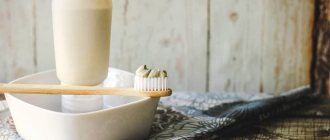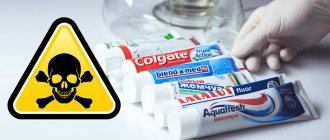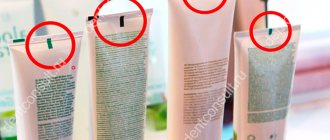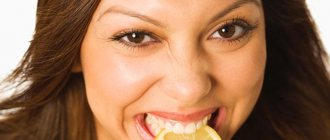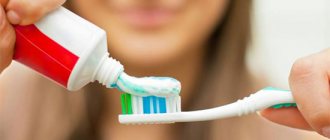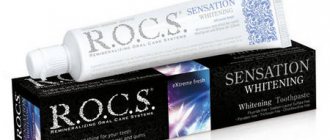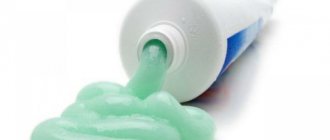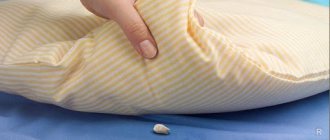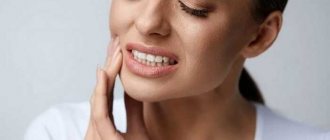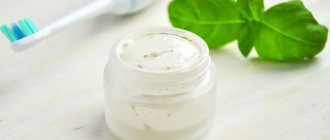| Place | Name | Characteristics in the rating |
| The best toothpastes for little ones |
| 1 | Apadent KIDS 0+ | The best toothpaste according to dentists |
| 2 | SPLAT Juicy Cherry 0+ | The most pleasant taste |
| 3 | Lacalut Baby | Optimal combination of price and quality |
| 4 | Biorepair Kids with strawberry extract | Often recommended by dentists |
| 5 | Eared Nyan First tooth | Budget toothpaste for little ones |
| The best toothpastes for children over 6 years old |
| 1 | Elmex Junior | The best option for switching to adult toothpaste |
| 2 | ROCS Junior Chocolate and Caramel | The most unusual taste of chocolate and caramel |
| 3 | SPLAT Junior Sweet tangerine | Natural composition |
| 4 | PresiDENT Junior lime | Good composition, fresh taste |
| 5 | Aquafresh My big teeth | Inexpensive pasta of good quality |
Recommendations for oral hygiene in children and prevention of dental diseases
The most frequently asked question to a dentist is: at what age should a child brush his teeth? This must be done from the day the first baby tooth erupts, that is, from about 6 months. In children under 1 year of age, you do not need to use a brush; you can take a gauze swab and gently, unobtrusively wipe the crown of the tooth. From 1-1.5 years old, you can use a small brush for children in a playful way and use toothpaste with a pleasant smell for the child. If you neglect oral hygiene at this age, caries may appear on baby teeth from 2-3 years of age.
It should also be noted that parents must monitor the quality of brushing their child’s teeth. Children are rarely conscious before the age of 8-10 years and can leave food deposits on the enamel, which will cause caries or gingivitis. Therefore, teaching children oral hygiene should be done in a playful way, but assessing it and, if necessary, gently correcting the child.
It is also necessary to pay attention to nutrition. A child's diet should consist of proteins (meat, cottage cheese), fats (sunflower oil, cheese) and complex carbohydrates (fruits, vegetables, whole grain bread). You need to carefully monitor the amount of simple carbohydrates (chocolate, sweets, baked goods) in the diet: you should not completely exclude them, as they are a source of positive emotions for the child. They should be given no more than once a day, and after eating carbohydrate foods you should rinse your mouth or brush your teeth.
Children's oral hygiene at the dentist has its own characteristics. In young patients, ultrasound is not used to remove stones; they simply polish the enamel with an electric brush with a special abrasive paste. After this, the teeth must be coated with fluoridated varnish to reduce the likelihood of caries.
Rating of the best children's pastes
- Splat Baby "Apple Banana". Suitable for children up to one year old. Along with the paste itself there is a special silicone brush that fits on your finger. In production, only natural ingredients are used, which makes it absolutely safe even if swallowed.
- Babycoccole . The manufacturer produces pasta in several flavors: strawberry, banana and apple. It does not contain any substances that may be harmful to the child or allergens. It has a pleasant taste, and most importantly, it prevents the development of caries.
- Chicco with strawberry flavor . Recommended for children over one year old. Does not contain fluoride, abrasives, is rich in calcium and xylitol, which prevents the development of caries.
- ROCS Kids "Citrus Rainbow" . Suitable for children aged 4 to 7 years. Its distinctive ability is the rapid formation of a protective layer on the surface of the teeth, which prevents the loss of calcium and phosphorus. Regular use reduces the likelihood of developing caries and inflammation of the gums, and also helps to normalize the microflora of the oral cavity.
- Biorepair Junior Mint – with sweet mint flavor. Recommended for use by children aged 7 to 14 years. It contains the proprietary micro Repair component, which has a protective effect and also restores microdamage to the enamel.
Toothpaste must be safe and of high quality. It should not contain sulfates, antibacterial substances, dyes, or flavors. Should be rich in calcium and lactic enzymes. Choosing the right toothpaste will improve the quality of your child's teeth and help you avoid expenses at the dentist's office. .
Research work “All the secrets of toothpaste”
- March 19, 2020
Everyone knows what toothpaste is, but has everyone ever wondered how it came about and what it consists of?
I was interested in this topic, and I decided to find out all the secrets of toothpaste. In order to find answers to the question, I set myself a goal: to learn as much as possible about toothpaste and its features.
To do this I need to solve the following problems:
- study the history of toothpaste;
- visit pediatric dentistry: https://wnwdental.com/ru/uslugi/dityacha-stomatologiya/
- conduct a survey;
- make toothpaste at home;
- give recommendations on the use of toothpaste.
To solve the problems, I identified research methods:
- Studying information in printed publications and Internet sites.
- Visit to the dentist.
- Questionnaire, survey.
- Observation.
The object of study is toothpaste.
The topic of my research is experimental, based on my own observations, experiences and experiments.
My research hypothesis Let's assume that it is possible to make toothpaste and powder at home.
Conclusion of the experiment: tooth powder is very easy to prepare and use, but it is worth noting that toothpaste tastes better and is easier to wash off the brush.
A general conclusion from the experiments: when I brushed my teeth with homemade toothpaste and tooth powder, I realized that I could replace store-bought toothpastes and powders with them. The hypothesis was confirmed - toothpaste and powder can be prepared at home.
Some “ancient” tips for caring for your teeth
- The famous scientist Pliny in the 1st century AD recommended putting crow or sparrow droppings mixed with oil in the ear.
- The same scientist Pliny advised eating a fried mouse once every two months as a preventive measure against caries.
- The procedure for getting rid of dental suffering was proposed 400 years ago by the German scientist Cardanus - he advised the patient to sit for several hours with his mouth open, turning towards the Moon: according to the medieval healer, the lunar rays have a beneficial effect on a diseased tooth.
Based on the material I have studied and visits to the dentist, I give some tips for caring for your teeth:
- Strictly follow the recommendations for using toothpaste, do not use large quantities of the product, do not keep it on your teeth for more than two to three minutes, and do not swallow it.
- Use whitening toothpaste no more than twice a week.
- After drinking tea or coffee, be sure to brush your teeth.
Conclusions of my work
Nowadays, almost all serious manufacturers offer a very wide selection of toothpastes, so more attention should be paid to the selection of toothpastes. But I am convinced that making pasta at home will be safer. Consequently, our smile will be healthy and attractive. With these words I would like to finish my research and wish everyone good health.
Research work “All the secrets of toothpaste”
Author: Irina Vavilina, 10 years old, 3rd grade student at the Municipal Educational Institution Gymnasium in Nadym, Yamal-Nenets Autonomous Okrug. Leaders: Olga Sergeevna Nedosekova, primary school teacher of the highest category, Municipal Educational Institution Gymnasium of Nadym, Yamal-Nenets Autonomous Okrug. Teaching experience 38 years. Nadezhda Leonidovna Timina, first category GPA teacher, Municipal Educational Institution Gymnasium in Nadym, Yamal-Nenets Autonomous Okrug. Teaching experience 7 years.
Which toothpastes should not be chosen for children?
As mentioned above, children under 10 years of age are not recommended to constantly use adult paste, as it will injure the enamel and cause increased sensitivity. For the same reason, you should not use dental whitening products (for example, Lacalut White paste), since the hydrogen peroxide they contain will cause pain and disrupt the structure of the hard tissues of the teeth.
You should not choose medicated pastes for children (the exception is when it was prescribed by a dentist). They can lead to disruption of the microflora of the oral cavity. This will cause candidiasis (fungal infection), which is very difficult to treat in children. These pastes include Lacalut Activ, Curasept, President and some others, which contain chlorhexidine or other antiseptics.
Testing and analysis of formulations of famous brands
Toothpaste for children should be as natural as possible, because 2 times a day the composition of the product is absorbed into the mucous membrane and can cause great harm to the body. You will have to give up bright berry and fruit flavors; organic products mostly have a light mint, non-irritating taste.
PRESIDENT Baby 0-3 for children from 0 to 3 years old
Paste with a light raspberry aroma of pink color and does not contain fluoride, sodium lauryl sulfate, parabens and PEG. The paste does not contain a high percentage of calcium.
Price - from 120 rubles Manufacturer - Italy
Environmental friendliness: 5 points, can be used!
Weleda with calendula from 0 to 3 years
The composition contains plant components that have a calming and healing effect - calendula extract, mint and fennel oils. The anti-inflammatory effect is provided by an extract from seaweed with a high content of alginate.
Without fluoride, parabens, PEG! But there is no calcium in the composition either - if a child is prone to caries, Weleda paste should be alternated with calcium-containing paste.
Price - from 200 rubles Manufacturer - Germany
Environmental friendliness: 5 points, recommend!
SPLAT Juicy Set for any age from 0 to 99 years
The paste is quite good, but it is recommended for use by those with thin enamel and stains on teeth, as it contains an impressive amount of calcium.
Does not contain fluoride, sodium lauryl sulfate or PEG! But there are fragrances and parabens.
Price - from 250 rubles Manufacturer - Russia
Environmental friendliness: 4 points
ROCS – PRO Baby fragrant chamomile from 0 to 3 years
One of the best toothpastes for children! Does not contain fluorine, parabens, dyes. At the same time, there is a minimal amount of calcium in the composition to strengthen teeth. Toothpaste with herbal chamomile extract and seaweed extract.
Price - from 220 rubles Manufacturer - Russia
Environmental friendliness: 5 points, definitely worth using!
Aquafresh - My first tooth
Surprisingly, the packaging of toothpaste intended for children under two years of age states “do not swallow.” In fact, a small child who has just started brushing his teeth does not yet understand that he needs to rinse his mouth and spit out all the contents. It is only by the age of two that he begins to understand and not follow his instincts. Manufacturers were negligent in their work by releasing a paste that was absolutely not designed for small children!
It contains all sorts of nasty things - fluoride, parabens, fragrance, synthetic preservatives.
Price - from 90 rubles Manufacturer - Slovakia
Environmental friendliness : 0 points, dangerous!
LACALUT kids 4+" from 4 to 8 years
The toothpaste is well advertised, but is absolutely not recommended for use. The composition contains fluorine, parabens, fragrance. Russian and German dentists actively advertise this paste, but only for material gain. Using hygiene products even with a low fluoride content on small children is dangerous!
Price - from 130 rubles Manufacturer - Germany
Environmental friendliness: 0 points, dangerous!
Drakosha Kalina with strawberry flavor
My childhood memory is Drakosha toothpaste, which I loved the taste of. In fact, this is a harmful paste that should never be used on children. Don't look at the "safe to swallow" label, it's not safe!
It contains many surfactants, preservatives, sweeteners, and fluoride. Many children develop fluorosis because of this paste!
Price - from 50 rubles Manufacturer - Russia
Environmental friendliness: 0 points, dangerous!
Dr.Hauschka Orange (Kinder Sensitiv Zahngel Orange)
It has a protective effect on the microflora of the oral cavity - it destroys harmful bacteria without harming beneficial ones. Contains mineral water, silica, medicinal plant extracts. Children really like the orange flavor - this is an example of a combination of a bright ethereal aroma with an absolutely natural composition. Only the price is not quite budgetary and it is difficult to find pasta of this brand for free sale.
Contains strengthening kaolin!
Price - from 350 rubles Manufacturer - Germany
Environmental friendliness: 5 points, quality product!
Children's toothpastes Natura Siberica
Recently, children's toothpastes from Natura Siberica have been gaining popularity. The composition is quite good, without fluorine, parabens and harmful synthetic components. But many people face the problem of insufficient cleaning of plaque from their teeth, which can result in the formation of tartar.
Price - from 200 rubles Manufacturer - Russia
Environmental friendliness: 4 points
Of the listed products, I will definitely recommend the products of Dr.Hauschka, ROCS, Weleda, PRESIDENT, SPLAT . The dental health of your children directly depends on your responsibility and attentiveness. Toothpaste for children must be chosen carefully!
Dangerous properties of fluorine
The safe paste is not always pleasant to the taste and foams well, but it will not cause any harm to the child. First of all, when choosing a paste, pay attention to the composition, and not to the manufacturer’s promises. It is quite difficult to find fluoride-free toothpaste in the mass market; many manufacturers consider this component an integral part of the composition. The only problem is that recent studies of fluoride have confirmed its harm! Only 10% of all inhabitants of the planet know about this.
Using fluoride is beneficial for manufacturers - it is a low-cost product and is used for processing aluminum, phosphate, and steel. But its harm is higher even than from arsenic!
Yes, fluorine as a microelement is necessary for the proper functioning of our body and its deficiency leads to deterioration in organ function. But toothpastes contain fluoride, which is not related to the fluoride we know. Fluoride is highly toxic! Imagine, a person has been using toothpaste and rinses with fluoride all his life, imagine how much of a harmful substance accumulates in the body, and then one day it suddenly shoots out in the form of oncology. Also causes mental confusion!
Moreover, young children really love to eat toothpaste with various berry flavors, but you can’t even hold a hygiene product with fluoride in your mouth for more than 2 minutes and you need to rinse your mouth well with water. That's why we choose fluoride-free toothpaste!
How to choose a toothbrush and toothpaste
Choosing toothbrushes is quite simple. There are a huge variety of different options. They can be of any shape and color, vary in degree of rigidity, and can be electric or conventional. The main thing you should pay attention to is the suitability of the child’s age and the material from which they are made. The brush should be made of safe, hypoallergenic materials so as not to harm your child.
It is worth paying attention to the age of the child and the material from which the brush is made.
You should be more careful when choosing toothpaste. Every parent, hoping to choose a good product for their child, goes shopping and, when they get to the store, they see a lot of beautiful, bright packaging on the shelves. But few people pay attention to what lies behind each of them. Beautiful packaging does not always promise a high-quality, safe product. So what should you pay attention to before buying and what is the best children's toothpaste?
The first thing you should pay attention to is the suitability of the child’s age and composition.
What should not be in children's toothpaste
- sulfate is the most dangerous component that the manufacturer uses to create foam. It has a harsh cleansing property and has an extremely negative and destructive effect on both gums and teeth.
- Dyes and flavors . To interest children and their parents in purchasing, there is an abundance of flavors, such as: Coca-Cola, ice cream, chocolate, etc. Their color is far from white, but bright and attractive - pink, red, purple, etc. Such a variety of colors and tastes can cause various allergic reactions in children, regardless of age. This is why purchasing such products should be avoided.
- Antibacterial substances. They can also be added to pasta. And no matter how it may seem that they destroy “bad” bacteria and fight caries, in fact they also have a strong effect on the microflora of the oral cavity. They can only be used for a short course when prescribed by a dentist during inflammatory processes in the mouth.
- Fluoride . Pastes containing fluoride are not recommended for children under 2 years of age, as they are not yet able to rinse their mouths thoroughly after brushing their teeth. This may result in swallowing some of the paste. However, fluoride remains a controversial ingredient. It is impossible to prove its negative effects in toothpaste 100%, but dentists still refrain from recommending such toothpastes to children under 2 years of age.
What should be in toothpaste
The main thing is that the toothpaste contains calcium and lactic enzymes.
- Calcium . An important component of any baby toothpaste. It is necessary for the formation of enamel (the one that covers our teeth and prevents hypersensitivity when eating something cold, or vice versa, hot).
- Lactic enzymes (lysozyme, lactoferrin, lactoperoxidase). All these components help to form the correct microflora of the oral cavity, as well as improve the protective properties of saliva.
So what is the best children's toothpaste?
Rating of children's toothpastes
The review was compiled to facilitate the selection of high-quality, safe, effective, universal paste. For this purpose, 30 applicants were selected and, by analyzing the main characteristics, 7 funds were included in the rating. These are the ones that customers and dentists most often speak positively about.
The following parameters became the guideline:
- Purpose – elimination of gum inflammation, strengthening enamel, protection against caries, prevention of plaque;
- Recommended age of the child;
- Composition – type and percentage of active and additional components;
- Available flavors;
- Packaging volume;
- Consistency and color;
- Contraindications for use;
- Speed of effect appearance;
- Economical consumption.
No less significant was the reaction of children to a particular product, as well as the price-quality ratio.
Composition of toothpastes for adults
One of the main components of toothpastes is fluoride, which at first glance is not only completely safe, but also helps to mineralize the dental tissue itself. But in children's pastes, the content of this more than useful component is minimized due to the fact that if particles of the paste are regularly swallowed, it can lead to health problems, since excess fluoride is harmful. Therefore, the increase in the percentage of fluoride in toothpaste is fully related to the age of the child: the older he is, the less chance of this element getting into the body. In addition, adult toothpastes may contain a number of components that simply should not be present in children's toothpastes. These, for example, may be ingredients whose task is to whiten.
Experienced dentists also find a way out of this situation, offering to compensate for the lack of fluoride in children's toothpastes by brushing adults' teeth once a week.
Why do you need to care for baby teeth?
Although baby teeth are temporary, they should also be well cared for: brushed daily and treated promptly. Otherwise, tooth enamel is destroyed and caries appears over time.
If an infection occurs, you may develop:
- pulpitis,
- inflammation,
- periodontitis.
The need to monitor oral hygiene increases if you like to please your child with sweets and cookies. This need grows stronger if the child’s diet contains a lot of fresh vegetables and fruits.
Most parents believe that breastfeeding, proper nutrition and the absence of sugar in the menu already guarantee healthy and strong teeth.
However, this is not at all true. Few people know about the harm that vegetable and fruit acids cause. As it turns out, your favorite fruits and some types of vegetables contain a lot of sugar and acids, which have a detrimental effect on enamel. For this reason, it is recommended to give your baby at least a drink of water after consuming these products.
We brush our teeth correctly!
Pediatric dentists strongly recommend starting to brush teeth from the first eruption.
It is necessary to wipe the first teeth after feeding with gauze. All food debris is removed and the risk of plaque is reduced. The bottle with pacifier must be removed immediately after the baby has eaten.
The question at what age should you brush your child’s teeth with toothpaste can be answered - from about 10-11 months you can already use a special children’s toothpaste for children
. Cleaning without paste is ineffective, and the bristles can leave small scratches on the enamel. Timely use of toothpaste can save you from caries or slow down its development.
Most parents are wary of toothpastes, considering them “chemicals.” But in this case, the benefit outweighs the harm. When purchasing, you should carefully study the composition. Perfect for little ones: Weleda dental gel, ROCS Pro Baby for little ones, Xlear Inc (Xclear) Kids Spry dental gel with xylitol. They are reasonably safe if accidentally ingested.
Another important point is the amount of toothpaste needed to brush your teeth. The “pea-sized” dosage is familiar to everyone from childhood, but for children this is too much. The recommended dose should be no more than a grain of rice
. For children who do not yet know how to rinse their mouth normally, this is enough.
To thoroughly clean the surface of the teeth, you need to move the brush from the gums towards the edges of the teeth. In this case, the lower row of teeth should be brushed from bottom to top, and the upper row from top to bottom. The gums also need to be gently massaged with rotational movements. This improves blood circulation and strengthens the gums. Brushing movements should be light and without pressure, otherwise the gums will be damaged and the enamel will be worn away.
It is also necessary to remove plaque from the tongue. This can be done by wrapping gauze around your finger or using a tool on a brush.
Which brush to choose
It is necessary to say a few words about the choice of brush.
- Up to a year,
you should give preference to brushes with silicone bristles. In children's stores you can even find special fingertips that are ideal for cleaning the first teeth. - After a year,
you can switch to soft bristles. Again, ROCS toothbrushes are perfect.
Maximkin set.
Many kids categorically refuse to brush their teeth. In this case, the behavior of the parents is of great importance. It is strictly forbidden to scold a child and force him to clean it forcibly, in this way you can completely interrupt his interest.
Tell your child why they need to brush their teeth. Read fairy tales on this topic and watch corresponding cartoons, for example, “Queen Toothbrush”, “Three Cats”.
